Susan Maxwell's Blog, page 5
September 8, 2023
Five For Friday #10: Occupations and Pastimes
As in life, so in that truer fictional world found in books—some have to toil for a living, others get to do as they please. This is reflected in five books chosen pretty much at random (except for the Saramago—let's face it, I was never going to not include a book with an archivistic slant).
The public archives, the Registry, in Saramago’s tale, has a distinct air of Borges or Calvino about it. There is something about the atmosphere that suggests the idiosyncratic purposes of The Library of Babel, or that the Central Registry should contain ‘Books That If You Had More Than One Life You Would Certainly Also Read But Unfortunately Your Days Are Numbered.’
The mechanical, hierarchical world of the Registry does not immediately lend itself to associations with such fantasy. The effect is partly achieved by the mix of vagueness (despite his job being concerned with Births, Marriages, and Deaths, Senhor José’s own surnames are not given, except to say that they are ordinary) and specificity (the smell of the Registry being half rose and half chrysanthemum). It is also achieved by the complex disruption of this authoritative place of control: Senhor José not only maintains a secret archives of celebrities, he overturns his world a second time in pursuit of an ‘ordinary’ person whose details he chances upon (on an index card).
2. Skating White Boots (Noel Streatfeild)
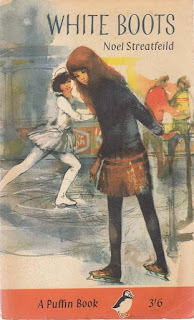
Noel Streatfeild was a writer whose work I read many times in my youth, and who was quite an influence, in subtle ways.
White Boots was published in 1951, fifteen years after her very famous Ballet Shoes. It tells the story of rich Lalla, being pushed to be the greatest figure skater in the world, and poor Harriet, taking up skating as part of her recovery from illness. Harriet is a very likeable, serious character, deeper and more realistic than Lalla. What also makes it interesting is the way in which their characters begin to be revealed, not just through their relationships with each other, but through the way they skate.
An added ‘occupational’ attraction is that of Harriet’s paternal uncle, a market gardener, who helps out his impoverished artist brother by letting him have whatever vegetables have not sold, resulting in some very random meals. Two polytunnels later, I know how that feels…
3. Mudlarking Elsetime (Eve McDonnell)
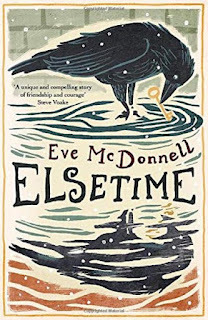
There are two main professions in this time-slip adventure: jeweller and mudlark. Glory is learning her trade as a jeweller and looks forward to the day that she can have own emporium, a dream she is determined to achieve. Needle scours the banks of the Thames for treasures that he can use or sell, along with trying to solve the mystery of how his father disappeared, and how to get him back.
Mudlarking, for anyone who has not come across it before, is scavenging along riverbanks for interesting items. It used to be a way of making a living, albeit a meagre one, and probably marginally less unsavoury than pure-finders who collected dog faeces for tanneries. The nineteenth century journalist, Henry Mayhew, included an interview with a teenaged mudlark in his descriptions of London.
In Elsetime, Needle has a second job of sorts, as curator of the history of everyday life around the Thames. He has a form of synaesthesia that means he can ‘see’ the stories attached to the items that he finds; his ‘memory’ of the events associated with his finds acts like a museum guide.
(You can read my review of Elsetime here.)
4. Sailing Swallows and Amazons (Arthur Ransome)
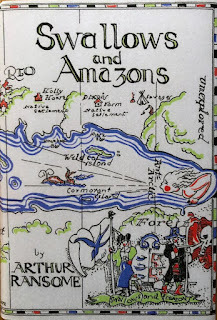
Anyone who watched, and remembers, Thelma and Louise may remember the scene where the truck-driver insults the eponymous characters, who take out guns and start shooting his truck. One says to the other, Where’d you learn to shoot like that? and the other says, T.V. I feel a bit like for a couple of hours after reading Swallows and Amazons—with such descriptions, I feel I could take on sailing a small boat around the Lake District, come what may.
Arthur Ransome’s tale recounts the adventures of the resilient and enterprising Walker and Blackett families and their surprisingly sang-froid parents. They acquire a common ‘enemy’, the Blackett’s grumpy uncle, and run a contest to see who can capture the other group’s dinghy. It is a very straightforward—that is, entirely unlikely—adventure story, but very vividly and realistically told. There’s even a parrot.
5. Chemistry The Sweetness at the Bottom of the Pie (Alan Bradley)
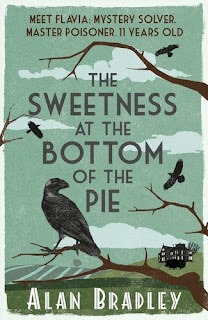
Flavia is the youngest daughter of the impoverished upper-class de Luce family. Her mother died while climbing the Himalayas when Flavia was a baby, and her father has never ceased mourning his loss. Although he retreats to his philately with the same dedication as his daughters Ophelia and Daphne show to romance and literature respectively, the very present absence of the late Harriet de Luce does not dim the joyfulness of the stories. They are told from Flavia’s perspective.
Flavia is fascinated by, and almost unfeasibly knowledgeable about, chemistry. She has had the great good fortune to find that an ancestor was similarly inclined, meaning that Flavia has access to a very well-equipped laboratory at her family’s dilapidated ancestral home, Buckshaw. Her delight in finding chemical ways to murder her sisters—with whom, as she sadly notes occasionally, she used to be friends—would be more worrying in an eleven-year-old who was less robust, articulate, and open than Flavia.
As is the lot of amateur detectives in fiction, she encounters murders at a rate that must mean the environs of Buckshaw would rival South L.A., or possibly even Cabot Cove, for their homicide statistics. Flavia has regular opportunities to put her encyclopaedic knowledge of chemistry to practical uses.
********
Right—off now to engage in the important pre-weekend pastime of testing that raspberry tincture I made a couple of months ago…

WEBSITE www.biblioref.com
FOLLOWSign up to the Newsletter for extra updates and offersMastodon Twitter LibraryThing Goodreads Facebook Instagram YouTube
BUY the BOOKSHollowmen Fluctuation in Disorder And the Wildness A Wild Goose Hunt Good Red Herring
Bibliothèque des Refusés is the imprint of independent author and scholar Susan Maxwell.

September 1, 2023
Five For Friday #9: Writing Soundtracks
An earlier Five for Friday focused on the excellent podcasts that provide me with nourishing entertainment. Listening during last week to one of those very podcasts (Weird Studies), I was introduced to the word ‘pseudomorph’; a term from mineralogy where a mineral compound appears in an atypical form. WS were using the term metaphorically, speaking of the ways in which one form of art adopts, or attempts to adopt, the forms of another. It was a bit like encountering ‘irreal literature’ as a genre, bringing a sense of relief that there is a context for something I had been drawn to, but wasn’t sure was even feasible.
Trying to find a way of writing that interacts with music is something I started to experiment with in the last few years. It arose, I think, partly because in trying to make imagined places more immersive, I realised I was relying heavily on image, and I made a conscious effort to include soundscapes. I also was very curious to see how well a narrative might progress if it was being driven by something other than a prosaic introduction/inciting event/crisis/resolution combination.
I am limited by my musical knowledge being neither wide nor profound (though I am being materially assisted by another previously-mentioned podcast, Sticky Notes), but I am chipping away at it. It has been very educational as an experiment, as it has made me more attentive both to writing and to listening.
1. Hollowmen (novel) / Maurice Ravel: Bolero
This was the first story in which I tried to incorporate a soundscape of sorts.
The main character, Cuffe, maintains rather pretentiously that she characterises as musical types, or instruments, the people she is employed to manipulate. Senior management were brass instruments (“they’re not called Top Brass for nothing”), the city itself was a viola da gamba, Dory Bathory was a power-ballad. And the degree to which Flynn-Lynn Pym would prove disruptive was foreshadowed by Cuffe’s deciding that Pym was not Tchaikovsky, but then being unable to place her at all.
Several pieces of music are mentioned in the novel—Mussorgsky’s Pictures at an Exhibition, works of Hildegard of Bingen—but the only piece that I tried writing to was Ravel’s Bolero, which influenced a couple of scenes where management are being dramatic, and also the Nature/Forest Voice sections.
I think trying out this idea for the first time while writing a quite complex novel was not the most likely route to success, but it was certainly educational.
2. And the Wildness (novel) / Seán Doherty Under-song
There was less room for experimentation in And The Wildness, as it has definite narrative that needs to be clear. At the same time, it is not without its mysterious and atmospheric element, which is focused very strongly on the Wilderness at Cobwell Farm.
For the sections related to the Wilderness, I listened often to the Mornington Singers’ 'Under-Song' album, especially Eoin Mulvany’s Is úar geimred, but very particularly, and repeatedly, to Doherty’s Under-Song.
3. The Meaning of Frogs (short story) / Carl Nielsen: Symphony No. 5
This was the first short story I wrote (or, rather, re-wrote) after I had finished Hollowmen. So, I had learned a few things about what to do (focus) and what not to do (try to implement everything that occurs to you all at once).
What I particularly wanted to try out in this story was finding an inspiration for what the pace should be, and how the narrative might develop under influences other than emotional or even dramatic development or tension. I needed a piece of music of a length that would allow me to see if I could pace the story with the music; I don’t know that it worked, exactly, because of my lack of musical expertise.
A particular attraction of Nielsen’s Fifth Symphony is the famous musical struggle between the orchestra and the violently disruptive snare-drum* in the first movement, which I associated with V falling into the water.
* Things really start kicking off about 14:40 minutes into the performance.
4. Hallowtide Boar (short story) / Claude Debussy: Trois nocturnes
Having tried out some ideas more carefully in …Frogs, I approached Hallowtide Boar from a slightly different angle.
It is a very disrupted and fragmented story. To avoid being definitive about what is or isn’t happening, I wanted it to be very impressionistic. I had also a very clear idea of the aesthetic I was looking for (inspired by Whistler’s Nocturne in Black and Gold which seemed suitable for Hallowe’en); and in pursuit of an impressionistic story, with an impressionistic painter, I went for an impressionistic musician, too.
I had not listened to Debussy very often before writing this, but discovered that he was apparently at least partially influenced by Whistler’s Nocturnes. So, Debussy it was—listening to the Trois Nocturnes again and again, and trying to both keep pace with it, and respond to it.
5. Each Tether Has Its End (short story) / Alfred Schnittke: Faust Cantata movement VII, 'Es geschah' ('It came to pass')
Although I did not know how the narrative was going to pan out, exactly, when I started writing it, I did have a very clear idea of the aesthetic and the atmosphere I was looking for with this story.
I wanted an atmosphere of rising progression, one that contained a definite sense of threat. I was looking for something that was operatic, and somewhat extreme, not so much in emotion as in event.
The nature of the Faust story invites a combination of violence and retribution; 'Es geschah' is in the form of a demonic tango, and even a slowed-down tango has a great, propulsive feel that was perfect for this tale of catharsis and apocalypse.

WEBSITE www.biblioref.com
FOLLOWSign up to the Newsletter for extra updates and offersMastodon Twitter LibraryThing Goodreads Facebook Instagram YouTube
BUY the BOOKSHollowmen Fluctuation in Disorder And the Wildness A Wild Goose Hunt Good Red Herring
Bibliothèque des Refusés is the imprint of independent author and scholar Susan Maxwell.

Main Template
August 18, 2023
Five For Friday #8: Five walks in the not-so-fictional woods
There's more to life than writing and reading—not much more, admittedly, but still… And this 'more' often finds its way into the writing in any case.
I got into walking/hiking in a roundabout way. In one of my London jobs, there was a stand of leaflets near the staff restaurant: these leaflets provided information about various leisure activities and events, including a guide to walking holidays in the UK.
My interest piqued by this, I started buying Country Walking Magazine to see what I might be letting myself in for. But then disaster struck, in the form of a slipped disc. It was only after two years of pain and misery, culminating in surgery, that I could even think of setting foot to ground in earnest.
This week, I present five walks in the three countries in which I have made my home.
1. Seven Sisters and hinterland (Sussex)
This was my first ever 'real' walk, undertaken to celebrate my recovery from back surgery. It was glorious: the beauties of the landscape vying with the exhilarating sense of liberation as I returned to full health and fitness. Every bit of it was a joy, not least the rooks and jackdaws nimbly hopping between tables for leftovers at the picnic area at the end of the walk.
2. Chopwell Woods (Tyne and Wear)
One of the aspects of living in the UK I came to treasure most was the public right to access to the countryside in the form of rights of way and right to roam. When I lived in the north-east of England, I could (and regularly did) literally walk out the door and within a matter of yards go through a roadside stile and continue the walk through open countryside. A favourite walk was to Chopwell Woods and back (the red location tag on the map being the start and end point); the woods feature in passing towards the end of Hollowmen.
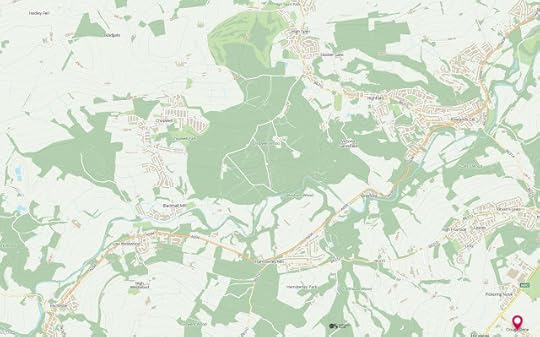
3. St. Cuthbert's Way (Scottish–English borders)
This is a long-distance linear walk, the first walking tour I booked as a formal holiday trip rather than making my way to each day's trailhead by car and bus. Walkers were brought to the start and collected at the end of the day's walk, and baggage transferred between successive nights' accommodation. Luxury! Fantastic countryside, starting in Melrose and ending in the Holy Isle of Lindisfarne, the places where St. Cuthbert (one of the more amiable saints) started and ended his religious life.

4. Parkland and Dunes around Den Haag
I much prefer the country to the city, but of all the urban environments in which I have lived, Den Haag is undoubtedly the most pleasant. Not the least of its charms is the presence of numerous leafy parks in the urban area itself, and unique dunelands in the peri-urban coasts—part of a long National Park extending along either side of the city. As this is the Netherlands, access couldn't be easier: either walking for the whole journey, or heading to a trailhead by bicycle and setting off from there.

5. Kinnitty Forest (Offaly)
The closest good walking country to me now can be found in the Slieve Bloom mountains, spread across the Laois–Offaly border. They offer a range of linear and looped walks, and while not mountainy in the way that, say, the Lake District is, some of the walks are far from unchallenging.
Ironically, given that I now live in the heart of the countryside, the biggest obstacle is access: there are no rights of way or national public walking paths in Ireland outside of specific areas such as national parks, so instead of nipping through a stile and off across the fields, it is the guts of an hour's drive to get anywhere to walk. My plan this year is to just take the bull by the horns, accept this reality, and do the necessary planning to get out more often: because once at the trail, there is an awful lot of loveliness to enjoy and explore.
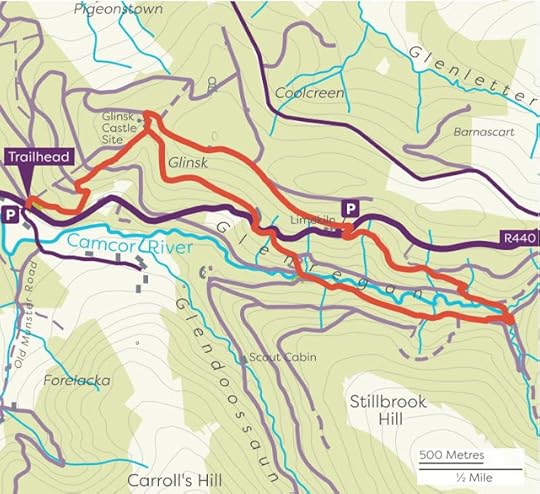

WEBSITE www.biblioref.com
FOLLOWSign up to the Newsletter for extra updates and offersMastodon Twitter LibraryThing Goodreads Facebook Instagram YouTube
BUY the BOOKSHollowmen Fluctuation in Disorder And the Wildness A Wild Goose Hunt Good Red Herring
Bibliothèque des Refusés is the imprint of independent author and scholar Susan Maxwell.

Five walks in the not-so-fictional woods
There's more to life than writing and reading—not much more, admittedly, but still… And this 'more' often finds its way into the writing in any case.
I got into walking/hiking in a roundabout way. In one of my London jobs, there was a stand of leaflets near the staff restaurant: these leaflets provided information about various leisure activities and events, including a guide to walking holidays in the UK.
My interest piqued by this, I started buying Country Walking Magazine to see what I might be letting myself in for. But then disaster struck, in the form of a slipped disc. It was only after two years of pain and misery, culminating in surgery, that I could even think of setting foot to ground in earnest.
This week, I present five walks in the three countries in which I have made my home.
1. Seven Sisters and hinterland (Sussex)
This was my first ever 'real' walk, undertaken to celebrate my recovery from back surgery. It was glorious: the beauties of the landscape vying with the exhilarating sense of liberation as I returned to full health and fitness. Every bit of it was a joy, not least the rooks and jackdaws nimbly hopping between tables for leftovers at the picnic area at the end of the walk.
2. Chopwell Woods (Tyne and Wear)
One of the aspects of living in the UK I came to treasure most was the public right to access to the countryside in the form of rights of way and right to roam. When I lived in the north-east of England, I could (and regularly did) literally walk out the door and within a matter of yards go through a roadside stile and continue the walk through open countryside. A favourite walk was to Chopwell Woods and back (the red location tag on the map being the start and end point); the woods feature in passing towards the end of Hollowmen.

3. St. Cuthbert's Way (Scottish–English borders)
This is a long-distance linear walk, the first walking tour I booked as a formal holiday trip rather than making my way to each day's trailhead by car and bus. Walkers were brought to the start and collected at the end of the day's walk, and baggage transferred between successive nights' accommodation. Luxury! Fantastic countryside, starting in Melrose and ending in the Holy Isle of Lindisfarne, the places where St. Cuthbert (one of the more amiable saints) started and ended his religious life.

4. Parkland and Dunes around Den Haag
I much prefer the country to the city, but of all the urban environments in which I have lived, Den Haag is undoubtedly the most pleasant. Not the least of its charms is the presence of numerous leafy parks in the urban area itself, and unique dunelands in the peri-urban coasts—part of a long National Park extending along either side of the city. As this is the Netherlands, access couldn't be easier: either walking for the whole journey, or heading to a trailhead by bicycle and setting off from there.

5. Kinnitty Forest (Offaly)
The closest good walking country to me now can be found in the Slieve Bloom mountains, spread across the Laois–Offaly border. They offer a range of linear and looped walks, and while not mountainy in the way that, say, the Lake District is, some of the walks are far from unchallenging.
Ironically, given that I now live in the heart of the countryside, the biggest obstacle is access: there are no rights of way or national public walking paths in Ireland outside of specific areas such as national parks, so instead of nipping through a stile and off across the fields, it is the guts of an hour's drive to get anywhere to walk. My plan this year is to just take the bull by the horns, accept this reality, and do the necessary planning to get out more often: because once at the trail, there is an awful lot of loveliness to enjoy and explore.


WEBSITE www.biblioref.com
FOLLOWSign up to the Newsletter for extra updates and offersMastodon Twitter LibraryThing Goodreads Facebook Instagram YouTube
BUY the BOOKSHollowmen Fluctuation in Disorder And the Wildness A Wild Goose Hunt Good Red Herring
Bibliothèque des Refusés is the imprint of independent author and scholar Susan Maxwell.

August 11, 2023
Five For Friday #7: Book Reviews
During the week, the Bibliothèque elves have been updating my book reviews on the website and on Goodreads. Writing reviews is a good way to get the ink flowing, and it also forces me to articulate my thoughts on the books I read. And, as an author, I know how valuable it is—especially for independent authors—to get this kind of feedback from readers. (I generally do not rate books using the star system: it is too blunt an instrument to give a fair assessment. There are multiple criteria for evaluating a book, and a single scale cannot capture that.)
The five reviews I have chosen reflect a range of book genres, and a range of reasons for review: I review for Children's Books Ireland and BookSirens as well as for my own pleasure.
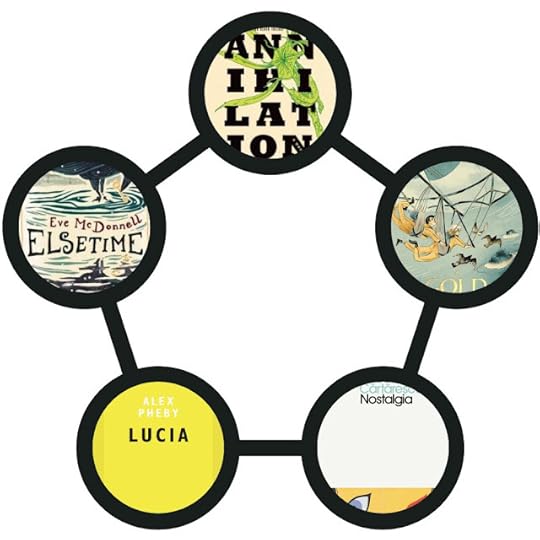
1. Annihilation by Jeff VanderMeer (Farrar, Strauss and Giroux: 2014). Southern Reach Trilogy #1.
2. Elsetime by Eve McDonnell (Everything With Words: 2020)
3. Gold by Geraldine Mills (Little Island: 2017)
4. Lucia by Alex Pheby (Galley Beggar: 2018)
5. Nostalgia by Mircea Cărtărescu; trans. Julian Semilian (Penguin Modern Classics)
By the way, anyone wondering where the July newsletter is: Reader, I didn't do one. There, I've admitted it! Normal service will resume for August.

WEBSITE www.biblioref.com
FOLLOWSign up to the Newsletter for extra updates and offersMastodon Twitter LibraryThing Goodreads Facebook Instagram YouTube
BUY the BOOKSHollowmen Fluctuation in Disorder And the Wildness A Wild Goose Hunt Good Red Herring
Bibliothèque des Refusés is the imprint of independent author and scholar Susan Maxwell.

July 28, 2023
Five For Friday #6: Some excellent podcasts
When I moved back to Ireland after an extended period of living and working abroad, the first few years were a bit stressful: building works, a PhD to finish, and so on. In reaction to this, my evening relaxations were as far removed from the intellectually demanding as possible—comfort-watching Murder, She Wrote, for example.
Eventually, things began to work themselves out and my brain decided that enough was enough, and demanded some more nourishing entertainment. This was when I discovered that there was a whole world of podcasts out there, where articulate, intelligent people discoursed fluently, knoweldgeably, and entertainingly on a vast range of topics.
So this Friday, I'm listing five of my favourite podcasts.
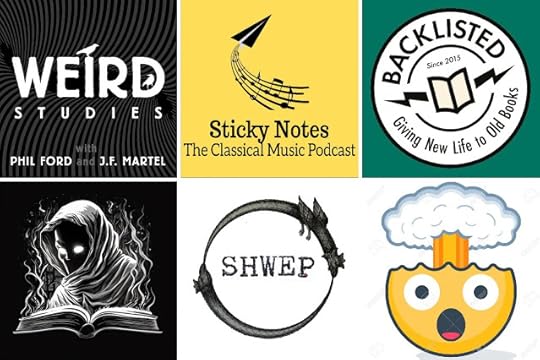
1. Weird Studies "Art and philosophy at the limits of the thinkable."
Presented by musicologist Phil Ford and film-maker J.F. Martel, this podcast combines intellectual rigour and speculative audacity as the two hosts "[dwell] on ideas that are hard to think and art that opens up rifts in what we are pleased to call 'reality'." Topics range from the music of Wagner to the metaphysics of Conan the Barbarian: all is grist to the mill. The effect is like injecting adrenaline straight into your mind; and the show is also often very, very funny.
Sample episode 81. Gnostic Lit: On M. John Harrison's The Course of the Heart
I enjoy listening to 'classical' music (using the term in its loose rather than precise sense, so anything from mediaeval to contemporary). But I have no musical training or education, and often feel that I am missing out on the finer aspects of appreciation. I am not confident that I understand music to the same degree that I understand literature or visual art. So this podcast, hosted by the renowned conductor Joshua Weilerstein, is exactly what I need. Articulate and extremely knowledgeable, he communicates both enthusiasm and understanding in a highly engaging manner.
Sample episodesStravinsky's The Rite of Spring, Parts 1 and 2
This podcast is a real treasure for anyone who loves books. It is hosted by independent publisher John Mitchinson and author Andy Miller, aided by an impressive array of high-calibre guests. The episode list is the menu for a lavish literary feast comprising books you have read long ago but are now suddenly reminded of, books you haven't read but always meant to, books you've haven't read and never wanted to (but now wonder whether you should), and books you've never come across before but now feel you must read.
Sample episode57. Huysmans A Rebours
This podcast is different from the others on my list. Instead of focusing on analysis, host and author Tony Walker reads a tale of the uncanny, the weird or the horrific each week—mostly short stories, but also some novels and novellas extended over several weeks. Effectively, it is a library of audiobooks of classics of the genre, as well as some of his own work. As with Backlisted, there is an enticing mix of the familiar and the unfamiliar. Tony has a very attractive reading voice, which adds greatly to the pleasure of listening to the tales, and to his delightfully rambling discussions afterwards.
Sample episode11. The Monkey's Paw by W.W. Jacobs
Despite the tongue-in-cheek (or, perhaps rather, metatextual) reference to 'secret knowledge', this podcast is in fact an unfolding of the rigorous academic "study of Platonism, Gnosticism, Hermeticism, the Kabbalah, alchemy, occultism, magic, and related currents of thought." Progressing chronologically from the ancient world to the present day, it offers an exploration of important—and frequently sidelined—aspects of intellectual history in a manner that is at once erudite and accessible. The series host, Earl Fontainelle (who has one of those voices that you'd happily listen to if he were reading his way through the phone directory), is joined by various other experts from time to time.
Sample episode3. Wouter Hanegraaff on Western Esotericism
So there you have it: the internet is my hedge-school!

WEBSITE www.biblioref.com
FOLLOWSign up to the Newsletter for extra updates and offersMastodon Twitter LibraryThing Goodreads Facebook Instagram YouTube
BUY the BOOKSHollowmen Fluctuation in Disorder And the Wildness A Wild Goose Hunt Good Red Herring
Bibliothèque des Refusés is the imprint of independent author and scholar Susan Maxwell.

July 21, 2023
Five For Friday #5: Film Adaptations of Books (b)
A few weeks ago, I listed five film adapations from literary sources that I thought were particularly well done. Today, I am outlining four that I found underwhelming and one that was downright awful …
1. Strangers on a Train (1951), dir. Alfred Hitchcock, starring Farley Granger, Robert Walker, Ruth Roman, and Kasey Rogers. Hitchcock’s daughter Patricia appears too, playing Ruth Roman’s little sister.
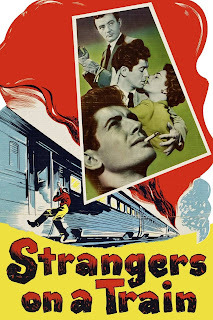
Patricia Highsmith adapted her own novel of the same name into a screenplay for Alfred Hitchcock. Hitchcock’s film has a great many good qualities, not a few of them arising from the performances of the four main characters.
Bruno Anthony (Walker) is suave and convincing, like all the best sociopaths, entangling wealthy, popular Guy Haines (Granger), who is only looking to perfect his life by marrying moneyed, elegant Ann (Roman), requiring him to divorce the scheming Miriam (Rogers).
It’s tense and claustrophobic, full of actions and twists—but unforgivably, it shys away from the splinter of ice in the heart of Highsmith’s original, a splinter that characterises and is essential to the power of her work. The fact that she performed the excision herself does not make it any better. Heartbreakers.
The main problem with this film was the desire to make a commercially successful, or at least popular, film from a book whose main characteristic is complexity—the subtle, multifarious interconnectedness of everything.
Eco intended the book to be accessible at different levels. Anyone could read it as a complex detective story with a medieval setting, a cross between Val McDermid and Brother Cadfael with an explicit nod to Sherlock Holmes. A reader with some knowledge of medieval history would get a little more, with a knowledge of theological conflict, more again, and so on.
A film of the book as a whole would be a very different film. For what it did, it wasn't bad: it looks great, they did not mess about with the murder-mystery layer that they had selected, Seán Connery was perfectly solid as William of Baskerville, and the fate of the library as devastating on screen as it was on the page.
A good job, but only a fraction of the original, retaining (as Eco apparently said) only the lettuce from a club sandwich.
3. Smilla's Sense of Snow (1997), dir. Bille August, starring Julia Ormond, Gabriel Byrne, and Richard Harris. Adapted from Miss Smilla's Feeling for Snow (1993), by Peter Høeg, translated by F. David from the 1992 Danish original.
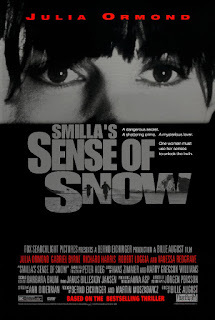
My lack of enthusiasm for this adaptation may arise from the same limitation as faced The Name of the Rose. Translating a work of art in one medium into another—art into literature, literature into film, and so on—is not the same as making a work of art in one medium (literature, in this case) into something that is popular in another medium.
A lot of the tensions, or imperatives, in Miss Smilla's Feeling for Snow lie in the main character's detached and inexorable response to her deeply-felt anger at particular injustices. The sense of inexorability was supported by the material details, but there is a limit to how much cinematic time can be spent on this, especially when there are more 'thriller-y' elements to be mined.
The other reservation I had was about Julia Ormond as Smilla Jaspersen. Ormond is, as always, excellent. But Smilla is a person of strong contrasts, and maintains them doggedly. Frances McDormand might have carried off commenting on her Valencienne ruffles on one page and seizing both ends of her stepmother in throttling grips on another, but Ormond can’t; she is too uncomplicatedly gamine and glamorous.
The film makes a good effort, but sides too much with the action-thriller possibilities to really do justice to the other qualities of the book.
4. The Golden Compass (2007), dir. Chris Weitz, starring Dakota Blue Richards, Nicole Kidman, Daniel Craig, and Sam Elliot. Based on Northern Lights (1995), the first of Philip Pullman’s His Dark Materials trilogy.
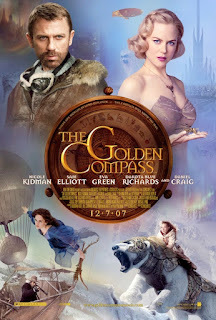
I find it hard to pin down exactly what is the matter with The Golden Compass, which I fully expected to love.
It can’t be easy to find a child actor who is sufficiently good at acting to carry a heavy role like Lyra Belacqua, happens to look right for the character, and looks right for a commercial film: that they did not succeed in the first two criteria is not surprising. In addition, the dialogue is a bit unleavened, but they were working from a somewhat ponderous source.
On the other hand, there ought to have been plenty of support to hold up the resultant weak spots in the film—it is great material, with a strong and distinctive aesthetic, packed with adventure and high moments, and they had a stellar cast, including Nicole Kidman, Daniel Craig, and Christopher Lee.
But there is something terribly shadowless about it. It’s very good in many ways, full of vim, and dash, and great scenes (and Sam Elliot is excellent). It is all very polished, and swirly-magic, and steampunk, with airships and armoured bears, but being so polished, it has the air of something expertly, but soullessly, done.
Pullman’s books (apart from the dialogue) are outstanding. They are unmistakeable. This film does not have any outstanding quality, it fits in to its genre too well—it is, literally, generic.
5. Alice in Wonderland (2010), dir. Tim Burton, starring Mia Wasikowska, Helena Bonham-Carter, Anne Hathaway, and Johnny Depp among others, and the voices of Alan Rickman, Christopher Lee, and others. “Based” on Lewis Carroll’s Alice’s Adventures in Wonderland (1865) and Through the Looking-Glass and What Alice Found There (1871).
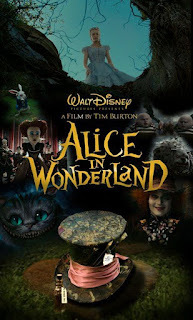
The innate anarchy of Lewis Carroll's original is crushed here, by the results of the common, but depressing, conviction that a cracking good classic story can be improved upon by adding or intensifying an emotional factor.
Tim Burton (and Linda Woolverton, who wrote the screenplay) ripped the hearts out of both of Carroll’s Alice stories, to produce a flaccid amalgamation of fantasy tropes. This Alice is not the unshakable, resourceful focus of a wild, anarchic plunge into unreality and mathematics, but a yawn-inducing late-teen social rebel, marriage-dodger, and saviour of the world, battling the Big Bad—the Red Queen and the Jabberwocky.
Most the characters from Carroll’s book appear, burderned with heavy-handedly quirky names (the White Rabbit, for example, is now Nivens McTwisp), and a role in the newly politicized world. We are not just through the looking-glass anymore, but in the Underworld, where Good (or at least, Irritating) clashes with, if not Evil, then at least Big Meanies.
Carroll's remarkable imagination is replaced by over-engineered appearances, and a frankly smug tendency to relentlessly extend scenes (like Alice's fall down the rabbit-hole) just to show off the CGI budget. Twitchy, exaggerated performances dominate, in a sickly aesthetic somewhere between Barbieland and mandrill monkey.
It is a travesty, and is virtually unwatchable.

WEBSITE www.biblioref.com
FOLLOWSign up to the Newsletter for extra updates and offersMastodon Twitter LibraryThing Goodreads Facebook Instagram YouTube
BUY the BOOKSHollowmen Fluctuation in Disorder And the Wildness A Wild Goose Hunt Good Red Herring
Bibliothèque des Refusés is the imprint of independent author and scholar Susan Maxwell.

July 14, 2023
Five For Friday #4: Book Illustrations
I have always been drawn to anything additional in a book. Not just footnotes (and only footnotes—endnotes are a punishment from the gods almost as maddening as in-line references), but any addition that extended the experience of the book's world: blurbs, 'about the author' paragraphs, the lists of books that used to appear in the backs of paperbacks, pressing you to add their other publications to your To Be Read pile.
Illustrations had the same sort of effect, they created a kind of hall of mirrors: reading the story created images, or impressions, and the illustration created another glimpse into the world, creating a depth, or a richness.
In my youth I preferred illustrations that, in effect, gave the impression of closing off the fictional world, defining it more precisely, adding to the story's single, representational meaning. I was not drawn so much to illustrations that seemed loose or inexact—Quentin Blake's work, for example—and it was only later that I had an appreciation of illustration that opens out the possibilities of the story, rather than closing them down.
So here, a little randomly as is appropriate, are some of the illustrations for which I have retained a great affection. A Flag for Camberwick Green is the first book I recall being given, by one of my siblings, and I was so delighted with it that I tried to eat it. It still has bite-marks. I was very young…
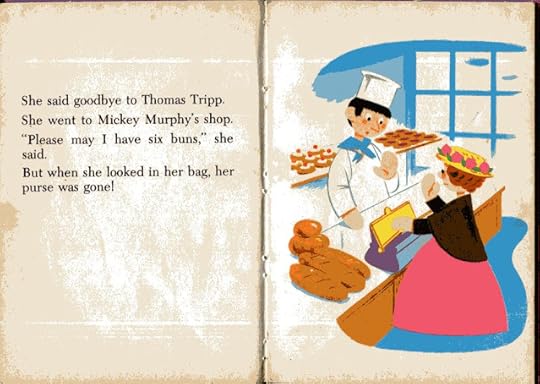
2. The Horse and His Boy
Text: C.S. LewisIllustrations: Pauline Baynes[Not the first Narnia book I read, but the first one that I bought.]
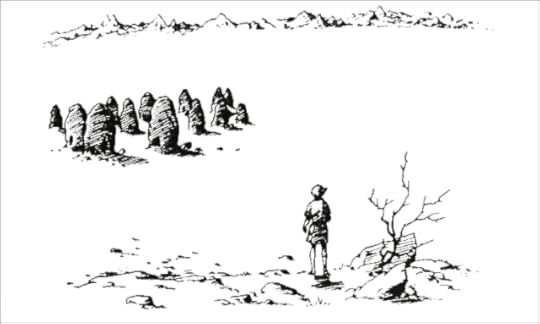
3. Sherlock Holmes: The Complete Illustrated Short Stories
Text: Sir Arthur Conan DoyleIllustrations: Various, but my favourite is Sidney Paget.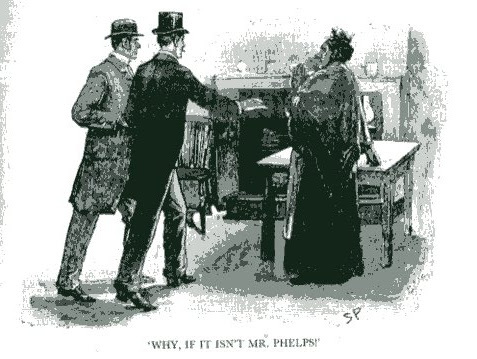
4. The 13 Clocks
Text: James ThurberIllustrations: Ronald Searle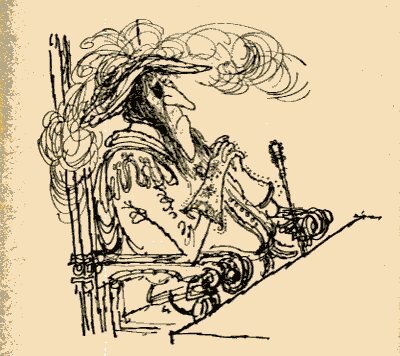
5. The Three Little Wolves and the Big Bad Pig
Text: Eugene TrevizasIllustrations: Helen Oxenbury[This is the odd one out: all the others are childhood favourites, but this I bought as an adult. The three anxious little wolves are just lovely.]
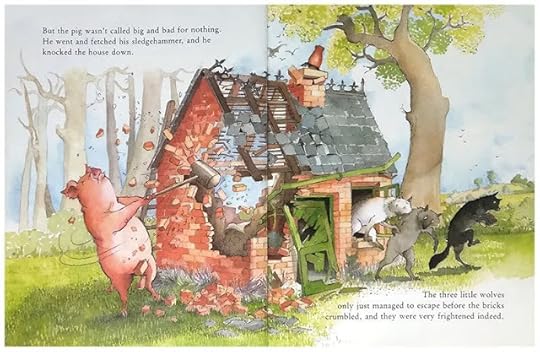

WEBSITE www.biblioref.com
FOLLOWSign up to the Newsletter for extra updates and offersMastodon Twitter LibraryThing Goodreads Facebook Instagram YouTube
BUY the BOOKSHollowmen Fluctuation in Disorder And the Wildness A Wild Goose Hunt Good Red Herring
Bibliothèque des Refusés is the imprint of independent author and scholar Susan Maxwell.

July 7, 2023
Five For Friday #3: Good grief, it's not Friday already, is it?
I was so preoccupied with planning for and hosting a family lunch yesterday that it has only dawned on me just now that it's Friday. And I am suppose to have come up with an idea for this week's five related whatevers. But to one who is by nature more misanthropic hermit than bonne vivante, feeding informal lunch to a handful of lovely familiar people is an undertaking of the order of magnitude of the Field of the Cloth of Gold.
And what, you might be curious to know, comprised this epic feast? Well, there was:
Stuffed bread (an excavated unsliced pan filled with a sort of meat/veg-loaf mixture, the lot then wrapped in tinfoil and roasted in the oven);Potato salad (this is Ireland, after all);Dips (tomato and black olive, hummus) with crudités (carrots and home-grown courgette);Cheese (lovingly hand-crafted, from a regional artisan producer) and Branston pickle (lovingly machine-crafted, from a multinational corporate producer);Boiled fruit cake* and home-made shortbread biscuits fancified by adding a dollop of marmalade and a covering of dark chocolate on top.So there you have it—five linked items, as per contract!

*And a bonus—here is the recipe. It is a quite forgiving recipe: you can leave some things out or substitute them, within reason (e.g. I had no cherries, so just left them out, and no currants, so substituted sultanas for them). It is easy to make; the baking time will depend on your own oven, it takes only a little over an hour in ours.
Boiled Fruit Cake
INGREDIENTS
6 oz sultanas6 oz currants
2 oz chopped walnuts
2 oz glace cherries
2 oz mixed peel
6 oz butter or margarine
3–4 oz granulated sugar [the original recipe calls for 6oz, but that is very sweet]
10 oz plain flour
4 eggs
1 tsp mixed spice
½ tsp baking powder
METHOD
Pre-heat oven to 180°C
Grease and line an 8” round or 7” square cake tin (a 2lb bread tin will do fine as well).
Put sultanas and currants in a saucepan; just cover with water, bring to the boil, and simmer for 15 min. Remove from heat and strain off liquid [keep it for a hot toddy: just add a dash of rum!]
Add walnuts, cherries, mixed peel, butter, and sugar; stir over a low heat until the butter has melted.
Beat the eggs and add to the fruit with flour, baking powder and spice.
Pour into cake tin and bake for 1 – 1½ hrs.

WEBSITE www.biblioref.com
FOLLOWSign up to the Newsletter for extra updates and offersMastodon Twitter LibraryThing Goodreads Facebook Instagram YouTube
BUY the BOOKSHollowmen Fluctuation in Disorder And the Wildness A Wild Goose Hunt Good Red Herring
Bibliothèque des Refusés is the imprint of independent author and scholar Susan Maxwell.

June 30, 2023
Five For Friday #2: Making a Spectacle of Myself
So it is that time of the random-number-of-years cycle, when I have to go and get my eyes tested, because I’ve stepped on my glasses, or I realise that they are so old and scratched that I can hardly see through them.
Off I tottered, and went through the usual routines of having puffs of air blown at my eyes, of having very steampunk-looking frames attached to my face, and of being asked pressing questions about whether the letters are clearer with this lens or with this one, and unable to escape the residual fear that my answer is in some way wrong.
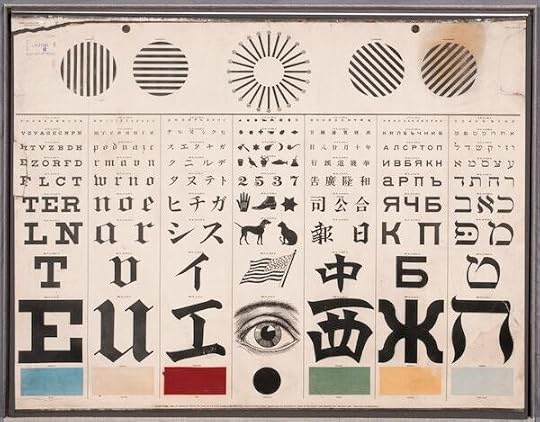 Eye Test Chart by George Mayerle, via The Public Domain Review
Eye Test Chart by George Mayerle, via The Public Domain ReviewThen I was packed off to choose a frame. As I moped about, picking up first one and then another (unable to see the effect, because I’m so short-sighted that if I got close enough to the mirror to see, my breath fogged it up), what came to mind was a scene from The Big Sleep.
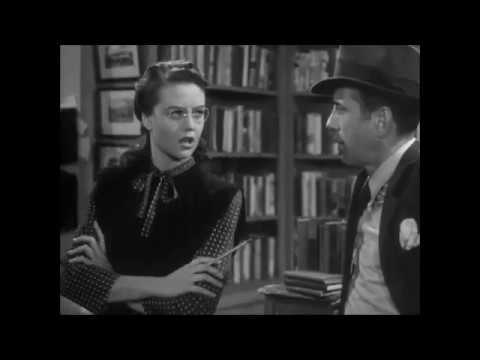
Philip Marlowe/Humprey Bogart is in a bookshop, dodging the rain and spying on another bookshop. He starts flirting with the bookseller, eventually cracks open a bottle of rye, and asks if she really needs to wear her glasses. Naturally when she takes them off, and unclips her hair, he’s all bowled over, as though she wasn’t already gobsmackingly beautiful.
I whiled away the minutes during the final part of the routine procedure—the wallet-extraction—calling to mind other writers who have sported glasses, these necessary implements, these disfigurements of underlying radiance, or short-cut signifiers of intellectual superiority.
Here we go, then: five of my favourite bespectacled authors, sporting their face furniture with panache.
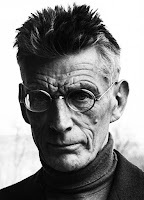
1. Samuel Beckett. Beckett is, among other things, my style icon. When I went to a local hairdresser to get my hair cut short, I brought a photo of Sam. You do the hair, I said, I’ll work on the wrinkles. I am never not impressed by the forcefulness of Beckett’s writing: maximum meaning and resonance packed into the minimum number of words.

2. Susanna Clarke. Piranesi is one of the most elegant books I’ve read in recent years; streamlined, proportionate, and complicated. The voice of the character is restful, without duplicity, endlessly curious; while all around are the strange, the eerie, and the threatening. It’s a remarkable combination.
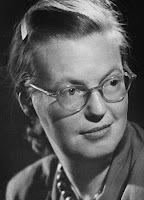
3. Shirley Jackson. I would read anything by Shirley Jackson. Her writing has a great clarity, and a great toughness. The first thing I read by her was The Haunting of Hill House, but possibly the coldest and most impressive was the short story 'The Lottery'. I’d pay good money to see Philip Marlowe tell her to take off her glasses.

4. M. John Harrison. M. John Harrison must, at this stage, be the patron saint of the underappreciated genius. Having read The Sunken Land Begins to Rise Again, I find it difficult to believe that any work of his is out of print (as The Course of the Heart is). I am a late convert, having come across him through the Weird Studies podcast. The Sunken Land is undramatic but inexorably unsettling; his focus seems to be the exact point where things fall apart; not in an apocalyptic way, but in the sense of having his eye always on the point where what seemed to be a unified thing disintegrates into its different parts. His ‘anti-memoir’, Wish I Was Here, is my latest purchase. Apart from glasses.

5. Muriel Spark. At the virtual launch we had for Bibliotheque des Refusés, one of the guests (hi, Siobhán!) said my sense of humour was ‘sharp and deep—like a stiletto’, and there is something quite stiletto-like about Spark’s writing. The Abbess of Crewe is a favourite: all that duplicity, all that smooth, concealing rhetoric… I love Memento Mori, too, with its uncanny aura and its many almost gleefully unpleasant characters.

WEBSITE www.biblioref.com
FOLLOWSign up to the Newsletter for extra updates and offersMastodon Twitter LibraryThing Goodreads Facebook Instagram YouTube
BUY the BOOKSHollowmen Fluctuation in Disorder And the Wildness A Wild Goose Hunt Good Red Herring
Bibliothèque des Refusés is the imprint of independent author and scholar Susan Maxwell.




